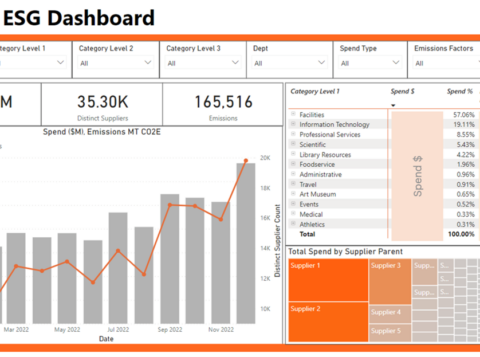How AI-Driven Tail Spend Management Is Revolutionizing Procurement for Retail, Higher Education, and More
This is an AArete Profitability Improvement insight
In an era of high interest rates and persistent inflation, businesses are under more pressure than ever to find innovative ways to reduce costs.
Many organizations have prioritized revenue growth over cost savings, focusing their procurement efforts on large, multiyear contracts with strategic suppliers.
These major strategic suppliers typically account for around 80% of vendor spend, leaving the remaining 20% — the ‘tail’ — largely unmanaged.
Now that the market has shifted, organizations are being pressured to find innovative cost-reduction strategies to address spend, thereby implementing tail spend management solutions, which is ripe with cost-saving opportunities if you know where to look.
What is Tail Spend?
Tail spend includes low-value purchases made across multiple suppliers with minimal oversight. These purchases often occur outside of preferred supplier agreements and lead to:
- Maverick spending leading to cost inflation
- Lack of visibility into procurement data
- Manual processes and supplier fragmentation that causes operational inefficiencies
For industries like retail and higher education, tail spend mismanagement can lead to disorganized procurement workflows, unnecessary costs, and lost savings opportunities. It often goes unaddressed because it’s complex to define and manage.
Effective management can address some of these challenges, but solving tail spend issues, identifying savings opportunities beyond the ’low-hanging fruit,’ and creating a sustainable approach to tail spend management can require organizational buy-in and expertise that may not exist within the organization.
Organizations need to define and understand their tail and put pressure on their teams to deliver a targeted solution for those suppliers and spend. With the rise of AI and the pressure to innovate for cost reduction, businesses are increasingly turning to tail spend technology and automation to identify opportunities and enhance their processes, not to mention tail spend management consulting services.
How to Identify & Manage Procurement Tail Spend
The first step in unlocking the full potential of tail spend is conducting a comprehensive spend analysis that covers all third-party vendor expenses. Many organizations draw an arbitrary line that tail-spend starts at a specific spend figure. However, if categories and segments are managed effectively and risk is understood, each spend category will have its own definition of tail spend. A “one-size-fits-all” approach is unlikely to deliver maximum value to an organization.
Use AI-Powered Tail Spend Management Software
Technology and AI are powerful tools for tail spend management in procurement and other processes, including these key areas:
- Supplier Rationalization: AI, supported by optical character recognition tools, can analyze invoice details to identify overlapping services and consolidation opportunities. Business units and procurement teams can also leverage AI assistants to steer supplier spend toward preferred suppliers. This streamlines the supplier base, improving user experience and making procurement more efficient and cost-effective. The challenge with AI is that vendors embed it in their tools, but it does not actually solve key client challenges.
- Cost Savings: The development of large language models (LLMs) has enabled AI assistants to automate negotiations. These assistants can also identify suppliers with favorable pricing agreements or help procurement teams launch early payment discount programs, where decreased payment terms are exchanged for discounts or rebates. One example of a company currently leveraging AI for tail spend management is Walmart, which uses an autonomous negotiation tool to renegotiate contracts with tail spend suppliers at a much faster pace than humans.
- Operational Excellence: Implementing AI spend management tools and analytics can transform procurement functions. These tools provide quick, actionable insights, enabling teams to make informed purchasing decisions and ensure compliance. AArete, for instance, has implemented AI solutions that drastically reduce the time needed for spend analysis, leading to more effective procurement operations.
Develop a Tail Spend Management Plan
Given the complexity of organizational spend, developing an effective tail spend management plan is essential. This involves analyzing criteria such as operational impact, complexity, and speed to potential savings.
Quick wins are possible in categories like staff augmentation, facilities management, and telecommunications through supplier consolidation and stronger governance. Identifying vendors with commoditized products can help achieve rapid savings, while higher complexity categories like business applications may require more advanced technical analysis and risk management.
An example of how AI can assist with these highly complex categories is leveraging a tool to track the utilization of business application software licenses to ensure the business is not paying for unused licenses.
Tail Spend Management Solutions for Retail, Higher Education, Healthcare & More
Because tail spend management challenges can vary by industry, our team wanted to provide a few examples of sectors that can benefit from tailored solutions that address their unique needs.
Federal Tail Spend Management
Procurement for federal agencies entails adherence to compliance requirements and regulations such as the Federal Acquisition Regulation (FAR), as well as their own specific policies. Utilize AI-driven spend management tools to automate procurement processes, confirm compliance, negotiate supplier contracts, and uncover hidden costs.
Healthcare Tail Spend Management
Similar to federal institutions, healthcare payers must abide by strict regulations (such as HIPAA). Insurance companies must manage procurement across administrative, claims, marketing, and IT systems. Healthcare organizations end up with hundreds of millions of dollars with their tail spend vendors, with minimal strategy to contain these costs. AI-powered tools and category-specific innovations will help payers ensure compliance, identify cost savings, streamline procurement, and uphold supplier relationships. Payers have an opportunity to start addressing their vendor spend all the way to dollar $0.
Higher Education Tail Spend Management
Universities by nature are highly decentralized creating an environment of small dollars, high-volume transactions, and vendors. To encourage savings and reduce inefficiencies, universities must centralize data across campuses and departments to get an optimal sense of their suppliers and spending categories. By doing so, these organizations can expect to discover cost-saving opportunities and make better, data-driven decisions, helping them easily pinpoint future spending needs.
Retail Tail Spend Management
Retailers are ripe for tail spend efficiency and cost savings gains – the proliferation of store management vendors, IT vendors, and merchandising vendors creates an environment for a massive set of tail vendors. Retailers have an opportunity to deploy category and vendor-specific tail spend strategies and tools to enhance visibility to their current environment and deploy real hard dollar cost savings strategies.
Achieving Tail Spend Efficiency
Tail-spend has long been a ‘black box’ for medium and large businesses. Despite its high transaction volume and lower dollar amounts, utilizing effective tail-spend management solutions can lead to millions of dollars in potential savings and organizational improvements.
As technology and AI advance, integrating these tools will become essential for all procurement teams. By leveraging AI to streamline processes, identify savings, and enhance compliance, businesses can unlock the hidden value within their tail spend.
To learn more effective tail-spend management strategies for your organization, visit AArete’s solutions page. Our tail spend management consultants ensure your team can improve efficiency, increase compliance, and reduce costs.






























































































